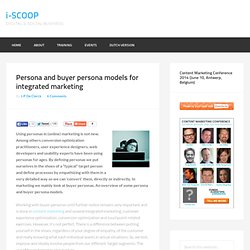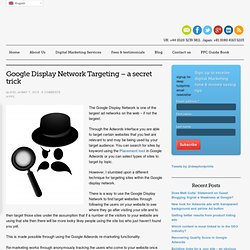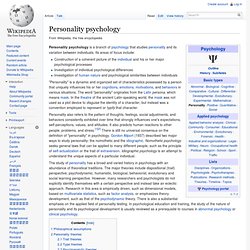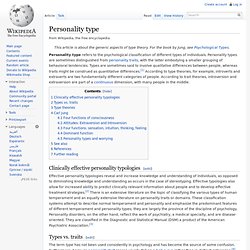

Content marketing personas: an introduction. Using personas in (online) marketing is not new.

Among others conversion optimization practitioners, user experience designers, web developers and usability experts have been using personas for ages. By defining personas we put ourselves in the shoes of a “typical” target person and define processes by empathizing with them in a very detailed way so we can ‘convert’ them, directly or indirectly. In marketing we mainly look at buyer personas. An introduction to personas and how to create them. Written by Tina Calabria, published March 2nd, 2004 Categorised under: articles, intranets, usability & information architecture, websites Before embarking on any intranet or website design project, it is important to understand the needs of your users.

It is then possible to identify the features and functionality that will make the intranet or website a success, and how the design can support users with different goals and levels of skill. Google Display Network Targeting. The Google Display Network is one of the largest ad networks on the web – if not the largest.

Through the Adwords interface you are able to target certain websites that you feel are relevant to and may be being used by your target audience. You can search for sites by keyword using the Placement tool in Google Adwords or you can select types of sites to target by topic. However, I stumbled upon a different technique for targeting sites within the Google display network. There is a way to use the Google Display Network to find target websites through following the users on your website to see where they go after visiting your site and to then target those sites under the assumption that if a number of the visitors to your website are using that site then there will be more looky likey people using the site too who just haven’t found you yet.
This is made possible through using the Google Adwords re-marketing functionality. This is the re-marketing process: How to Create Marketing Personas. Marketing personas are imaginary versions of your prospects, customers and the public that contain in-depth, lifelike character traits, including fun names, to help develop content and marketing.

Personas guide a firm’s marketing and content decisions. It’s useful to develop at least three different personas with unique traits. 12 point marketing persona checklist Developing personas for your various market segments requires an understanding of your customer base. 16 Personality Factors. The Sixteen Personality Factor Questionnaire (or 16PF),[1] is a multiple-choice personality questionnaire which was developed over several decades of research by Raymond B.

Cattell, Maurice Tatsuoka and Herbert Eber. Beginning in the 1940s, Cattell used the new techniques of factor analysis (based on the correlation coefficient) in an attempt to try to discover and measure the source traits of human personality (Cattell, 1946)(Nevid, 2009).[2][3] The questionnaire measures the 16 primary traits, and the Big Five secondary traits,[4][5] which have become popularized by other authors in recent years. Trait theory. In psychology , trait theory is an approach to the study of human personality .

Trait theorists are primarily interested in the measurement of traits , which can be defined as habitual patterns of behavior, thought, and emotion. [ 1 ] According to this perspective, traits are relatively stable over time, differ across individuals (e.g. some people are outgoing whereas others are shy), and influence behavior. Gordon Allport was an early pioneer in the study of traits, which he sometimes referred to as dispositions. In his approach, central traits are basic to an individual's personality, whereas secondary traits are more peripheral.
Common traits are those recognized within a culture and may vary between cultures. Personality psychology. Personality psychology is a branch of psychology that studies personality and its variation between individuals.

Its areas of focus include: Construction of a coherent picture of the individual and his or her major psychological processesInvestigation of individual psychological differencesInvestigation of human nature and psychological similarities between individuals "Personality" is a dynamic and organized set of characteristics possessed by a person that uniquely influences his or her cognitions, emotions, motivations, and behaviors in various situations. The word "personality" originates from the Latin persona, which means mask.
In the theatre of the ancient Latin-speaking world, the mask was not used as a plot device to disguise the identity of a character, but instead was a convention employed to represent or typify that character. The study of personality has a broad and varied history in psychology with an abundance of theoretical traditions. Philosophical assumptions[edit] 1. 2. Personality type. Clinically effective personality typologies[edit] Effective personality typologies reveal and increase knowledge and understanding of individuals, as opposed to diminishing knowledge and understanding as occurs in the case of stereotyping.

Effective typologies also allow for increased ability to predict clinically relevant information about people and to develop effective treatment strategies.[2] There is an extensive literature on the topic of classifying the various types of human temperament and an equally extensive literature on personality traits or domains. These classification systems attempt to describe normal temperament and personality and emphasize the predominant features of different temperament and personality types; they are largely the province of the discipline of psychology.
Personality disorders, on the other hand, reflect the work of psychiatry, a medical specialty, and are disease-oriented. Types vs. traits[edit] Type theories[edit] Persona (user experience) In marketing and user-centered design, personas are fictional characters created to represent the different user types within a targeted demographic, attitude and/or behavior set that might use a site, brand or product in a similar way.

Marketers may use personas together with market segmentation, where the qualitative personas are constructed to be representative of specific segments. The term persona is used widely in online and technology applications as well as in advertising, where other terms such as pen portraits may also be used.